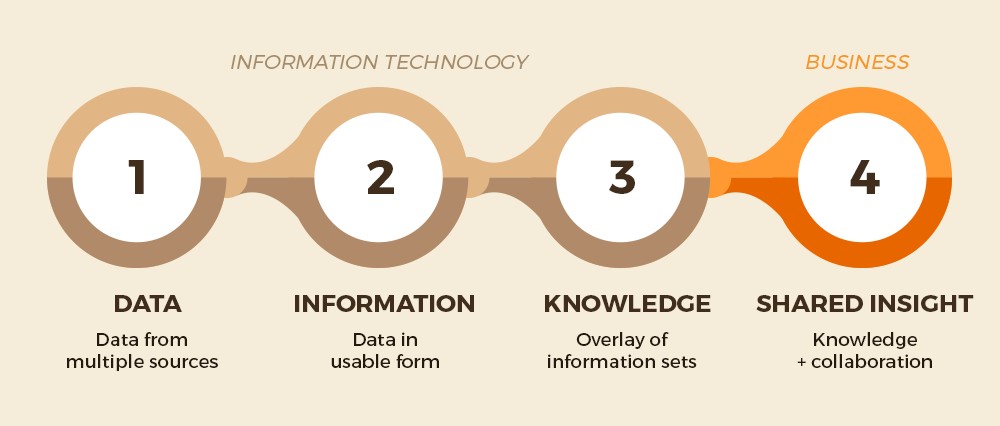
Perhaps you googled ‘data governance’, a major buzzword these days. Perhaps you were reading up on its growing significance and are considering establishing a data governance program in your organization. Or perhaps your organization already has such a program and you want to know more about it.

Whatever the reason, you are in the right place. Effective data governance is what helps a business scale the data value chain and turn terabytes of data into meaningful, actionable insights. Without a formal data governance strategy, businesses are bound to face multiple challenges that can pile up and eventually collapse.
The Data Value Chain

So, what happens if you don’t yet have data governance policies in place?
- Decisions get delayed.
- The right decisions don’t get made.
- Everyday productivity suffers.
- Business performance, on the whole, goes for a toss.
What can be the impact of poor data governance?
If you’ve heard anyone in your organisation say any of the following, you are ready for data governance.
1. There’s lots of data but nobody knows what to do with it.
Did you know that over 90% of the world’s data was created in only the past two years? And according to this report by DOMO, 1.7MB of data will be created every second for every person on earth by 2020. Big Data is only going to get bigger and its applications are many.
But for organizations, the challenge is less about availability and more about the explosion in the volume of unstructured data and the variety of data formats they will have to store, index and process. To add to the complexity, this data will be dynamic and changing in real-time. And given the rate at which Big Data is exploding, there is definitely a need for trained and experienced data scientists and analysts who can build systems. Having a data governance program that aligns with the business’ overall goals and strategy helps bring a method to the madness.
2. One or the other team is always complaining that they don’t have the right data.
When it comes to data, bigger isn’t always better; what’s important is that every team or function in the organization has ready access to the data that is relevant to their functioning. For instance, Amazon collects exabytes of data from all its customers, but its success depends on its ability to provide the right data to each team—geographic locations and order information to improve warehousing and logistics, customer profiles and search histories to impact customer experience, or cancellation and return histories for better vendor management.
A data governance program aligns the needs of all data stakeholders and ensures that the right data reaches the right person in a timely manner.
3. Because the data is of such poor quality, it’s almost impossible to make business decisions based on it.
Bad Data is data that is inaccurate, erroneous, unreliable, incomplete or unformatted. Anything from missing fields and duplicate entries to misspells and invalid formatting can make data ‘go bad’ and this is definitely not good news for any organization. Eliminating bad data to 100% accuracy is next to impossible but this number can be significantly reduced by developing good data governance plan and processes around the capture, storage, and indexing of data.
4. You don’t know if your data is compliant with regulations.
Starting with GDPR in the EU, countries everywhere are passing new regulations that govern how organizations collect, store, access and use the data of their customers. Given that this wave of change is happening for the first time at such a scale, this implies a massive change in the way organizations do business. Not to mention the confusion that abounds in the interpretation of some of the new regulations. Any organization that fails to comply with these risks heavy penalties.
So what is the best defense you can put forward? An effective, forward-looking and formal data governance strategy that proactively identifies use cases and guides data stakeholders at all levels on how to use organizational data.
5. The CIO or IT has to repeatedly step in to solve issues arising out of bad data.
Much of the organization’s decision making depends on the quality and reliability of the data that flows into the analytics pipeline. When this data goes bad, it starts impacting the business negatively, with serious financial repercussions. IT ends up spending precious man-hours sifting through bad data to resolve issues, bloating business processes and delaying business decisions. And no matter how many times this data is ‘cleaned up’, as soon as fresh data flows in, it gets messed up again.
An effective DG program helps eliminate bad data at three stages: at the entry stage through data cataloging standards and checks; at the data migration stage when data from disparate sources is collected into a centralized repository; and at the integration stage by building a unified view for all concerned stakeholders and defining levels of access.
6. The business’ entire ecosystem starts to get affected.
The absence of data governance will be felt not just by the business but also the vendors, suppliers and partners that make up its ecosystem. Bad data, for instance, can result in process delays or inefficiencies. Another big concern is around the security and privacy of data shared by these external stakeholders. If not arrested early on through effective data governance, all of these could erode the business’ reputation.
Thus, a data governance program can provide value to different facets of the business, from everyday decisions to data-intensive enterprise-level initiatives. Trying to set up such a program without appreciating its importance to every business unit could end up being a project focused on data quality but with no higher purpose.
Need help doing this? We work with clients to collaboratively build a data governance plan, create a roadmap and drive the program enterprise-wide.


